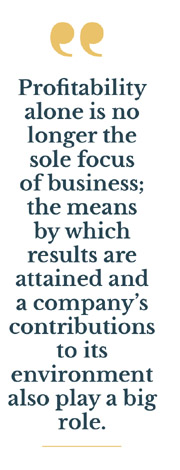ESG has become a well-known acronym in recent years. It defines the environmental, social and governance profiling of companies. Companies that strive to excel in ESG, in addition to their products and services, have successfully enhanced their performance and communicated their achievements and transformations to stakeholders over the past several years. It was only a logical step forward when the European Commission initiated the European Corporate Sustainability Reporting Directive CSRD, which puts ESG reporting into practice and subsequently establishes mandatory standards for it. In practice, this means that many more companies will soon be doing non-financial reporting alongside financial reporting.
ESG reporting will be mandatory only for companies that meet at least two of the following three criteria: assets worth over €20 million, net turnover exceeding €40 million, or employing over 250 individuals. It is estimated that around 700 companies in Slovakia will fall under this requirement. What about the rest? Even though they are not currently obligated to do so, I strongly advise them to initiate the process of data collection and implementing ESG measures as soon as possible.
Banks and customers are interested in your ESG profile
Non-financial ESG reporting will measure intangible parameters, i.e. how the firm burdens its environment and vice-versa. The European Commission is starting to require companies to behave sustainably and to regularly measure their impact on their surroundings. The ESRS standards just approved what is to be tracked and disclosed.
Why should companies not subject to this requirement also embrace this practice? The basis is the same as today: the desire to differentiate themselves and meet the expectations of their customers and other stakeholders. Profitability alone is no longer the sole focus of business; the means by which results are attained and a company’s contributions to its environment also play a big role. This is a natural dimension of business for responsible companies. The ESRS standards provide a framework for this dimension of business that can be an excellent guide for companies on where to monitor the impact of their activities and how to improve.
The fact is that ESG factors already play a role in bank financing today. According to the European Banking Authority guidelines, banks are required to assess environmental, social and corporate governance factors alongside financial risks when lending from June 2021. This may result in an adjustment of the interest rate (up or down).
This step is not the end of the current impact of ESG factors on business. Those who work with large companies know that they already require ESG information from their supply chains for their reporting. In other words, large buyers are considering the ESG performance of their suppliers. This is another reason even for a smaller company with no formal obligation to start monitoring and improving its ESG performance.

Self-assessment questionnaires for initial measurement of ESG profile
The way in which a company impacts the environment, treats its employees, and conducts its operations is soon to be scrutinized by a growing number of business partners and an expanding segment of the general public. The willingness of banks to lend to projects or companies that are not environmentally or socially sustainable will logically decline. And as trading partners will find companies with poor ESG scores in their value chain making their own business more difficult, they will logically sooner or later start to look around for a more responsible substitute. It’s a change that will come inevitably. Therefore, those who are responsible consider the long-term outlook of their business have nothing to hesitate over.
The fact is that reporting under the ESRS standards is not exactly straightforward. To “measure” your ESG profile, you need quite a lot of data from different areas, especially regarding HR, energy supply, production, etc. Self-assessment questionnaires are helpful in this situation, guiding companies on what data to collect and where to look for it. One of the first questionnaires adapted for Slovakia is the Synesgy project, which is represented by CRIF. I also work with this tool within my advisory practice. After free registration, you can fill in the questionnaire with individual data and the result is the overall ESG score, i.e. the company’s rating together with recommendations for improvement.
Measuring performance based on ESRS standards will be a clear shift for companies. Most, in my experience, have so far chosen energy savings as their primary focus within ESG. Companies have typically addressed the installation of photovoltaics on building rooftops or the replacement of older lighting with energy-efficient LED lights due to rising energy costs. This is undoubtedly a good starting point, which can now be followed up with environmental and social measures, including equal treatment and pay for employees.
ESRS standards will be phased in
Due to the demanding nature of ESRS standards in terms of data collection, their implementation will be gradual. This means that all standards (except the ‘general requirements’ ESRS 1 and the ‘general disclosures’ ESRS 2) will be subject to materiality assessments. . Each company will independently evaluate the significance of specific ESG parameters. However, if it decides a particular sustainability topic to be non-material, it will have to justify this. The aim is not to overwhelm companies with a new, complex obligation, but to allow for a gradual ramp-up to assess impacts on the surroundings. . As this global trend is inevitable, the early introduction of the rules gives European companies, including smaller ones, a chance to be at the cutting edge in this area.
Peter Vaško, Consultant, Grant Thornton Advisory



Follow us